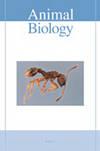青藏高原特有蟾蜍布林蛙的两性异形
IF 0.9
4区 生物学
Q2 ZOOLOGY
引用次数: 3
摘要
两性二态性的进化长期以来一直吸引着进化生物学家,理论表明两性二态性的变化是雄性和雌性在形态特征上不同的选择力的结果。本文基于体型等16个形态计量性状的两性变异模式,分析了布伦格氏懒蟾蜍(Scutiger boulengeri)大小和形态的性别差异。结果表明,该蟾蜍在体型和某些体型(如头长宽、鼻间、眶间、下臂直径和胫骨宽度)上存在明显的性别二态性。雌性较大的体型可能与繁殖力选择有关,雄性较大的头部以及更宽的鼻间和眶间空间可能与雄性竞争结合生态选择有关,雄性强壮的前肢和后肢可能与交配和竞争行为有关。这些结果讨论了有关上述选择程序和生活史性状可能的性别差异。本文章由计算机程序翻译,如有差异,请以英文原文为准。
Sexual dimorphism in Scutiger boulengeri, an endemic toad from the Tibetan Plateau
The evolution of sexual dimorphism has long fascinated evolutionary biologists and theory suggests that variation in sexual dimorphism is a consequence of selective forces acting differently on morphological traits in males versus females. Here, we analyzed sexual differences in size and shape of the Boulenger’s lazy toad, Scutiger boulengeri, based on the intersex variation pattern of sixteen morphometric traits including body size. The results suggested that sexual dimorphism was apparent in body size and some body shapes (e.g., head length and width, internasal space, interorbital space, diameter of lower arm and tibia width) of this toad. The bigger body size in females may be relevant to fecundity selection, a larger head in males as well as a broader internasal and interorbital space may be subject to male-male competition in combination with ecological selection, and both robust forelimbs and hindlimbs in males may be related to mating and competitive behaviors. These results are discussed with respect to the above selection procedures and possible sex differences in life history traits.
求助全文
通过发布文献求助,成功后即可免费获取论文全文。
去求助
来源期刊

Animal Biology
生物-动物学
CiteScore
2.10
自引率
0.00%
发文量
34
审稿时长
3 months
期刊介绍:
Animal Biology publishes high quality papers and focuses on integration of the various disciplines within the broad field of zoology. These disciplines include behaviour, developmental biology, ecology, endocrinology, evolutionary biology, genomics, morphology, neurobiology, physiology, systematics and theoretical biology. Purely descriptive papers will not be considered for publication.
Animal Biology is the official journal of the Royal Dutch Zoological Society since its foundation in 1872. The journal was initially called Archives Néerlandaises de Zoologie, which was changed in 1952 to Netherlands Journal of Zoology, the current name was established in 2003.
 求助内容:
求助内容: 应助结果提醒方式:
应助结果提醒方式:


